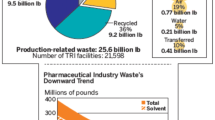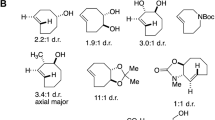Abstract
The degradation of aromatic compounds has long been considered to require dioxygen as co-substrate for oxygenases. However, in anoxic environments anaerobic bacteria employ dearomatizing aromatic ring reductases as key enzymes for the catabolism of aromatic substrates. Surprisingly, there are three totally different biological solutions for the difficult reductive attack on the resonance stabilized aromatic ring system. The dearomatizing reductase classes use FeS-clusters, W-pterins, or flavins as cofactors in their active sites.
Similar content being viewed by others
Literatur
Fuchs G, Boll M, Heider J (2011) Microbial degradation of aromatic compounds — from one strategy to four. Nat Rev Microbiol 9:803–816
Thiele B, Rieder O, Golding BT et al. (2008) Mechanism of enzymatic Birch reduction: stereochemical course and exchange reactions of benzoyl-CoA reductase. J Am Chem Soc 130:14050–14051
Kuntze K, Kiefer P, Baumann S et al. (2011) Enzymes involved in the anaerobic degradation of meta-substituted halobenzoates. Mol Microbiol 82:758–769
Wischgoll S, Heintz D, Peters F et al. (2005) Gene clusters involved in anaerobic benzoate degradation of Geobacter metallireducens. Mol Microbiol 58:1238–1252
Kung JW, Löffler C, Dörner K et al. (2009) Identification and characterization of the tungsten-containing class of benzoylcoenzyme A reductases. Proc Natl Acad Sci USA 106:17687–17692
Kung JW, Baumann S, von Bergen M et al. (2010) Reversible biological Birch reduction at an extremely low redox potential. J Am Chem Soc 132:9850–9856
Löffler C, Kuntze K, Vazquez JR et al. (2011) Occurrence, genes and expression of the W/Se-containing class II benzoylcoenzyme A reductases in anaerobic bacteria. Environ Microbiol 13:696–709
Kaster AK, Moll J, Parey K et al. (2010) Coupling of ferredoxin and heterodisulfide reduction via electron bifurcation in hydrogenotrophic methanogenic archaea. Proc Natl Acad Sci USA 108:2981–2986
Buckel W, Thauer RK (2013) Energy conservation via electron bifurcating ferredoxin reduction and proton/Na(+) translocating ferredoxin oxidation. Biochim Biophys Acta 1827:94–113
Meckenstock RU, Mouttaki H (2011) Anaerobic degradation of non-substituted aromatic hydrocarbons. Curr Opin Biotechnol 22:406–414
Eberlein C, Estelmann S, Seifert J et al. (2013) Identification and characterization of 2-naphthoyl-coenzyme A reductase, the prototype of a novel class of dearomatizing reductases. Mol Microbiol 88:1032–1039, doi: 10.1111/mmi.12238
Author information
Authors and Affiliations
Corresponding author
Additional information
Matthias Boll Jahrgang 1965. Biologiestudium an der Universität Freiburg. 1996 Promotion. 1998–1999 Postdoc am John Innes Center in Norwich, UK. 1999–2006 Arbeitsgruppenleiter am Institut für Biologie an der Universität Freiburg. 2002 Habilitation für das Fach Mikrobiologie. 2006–2012 Professor am Institut für Biochemie, Universität Leipzig. Seit 2012 Professor am Institut für Biologie, Universität Freiburg.
Rights and permissions
About this article
Cite this article
Boll, M. Aromatenreduktion am negativen Ende der biologischen Redoxskala. Biospektrum 19, 485–488 (2013). https://doi.org/10.1007/s12268-013-0341-x
Published:
Issue Date:
DOI: https://doi.org/10.1007/s12268-013-0341-x




